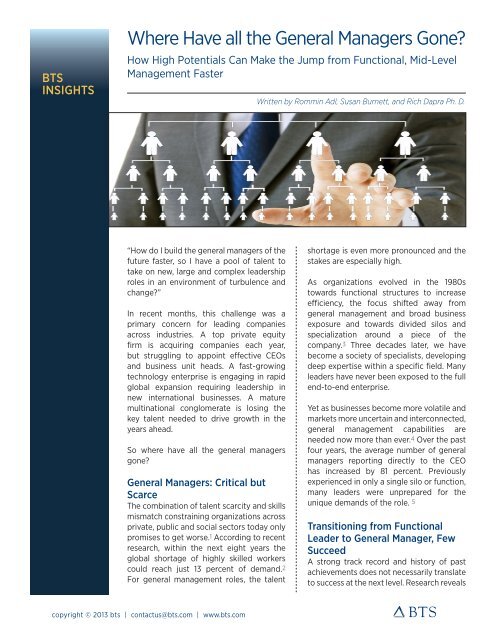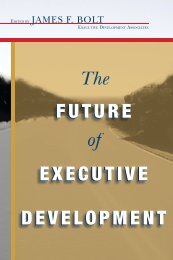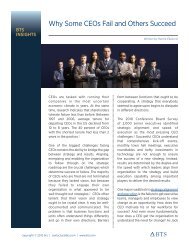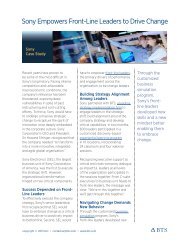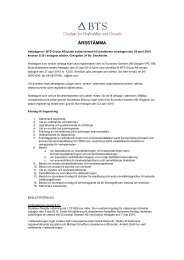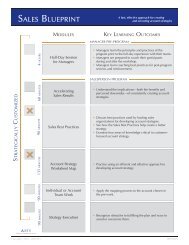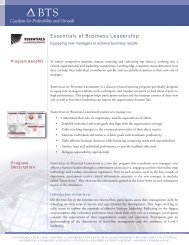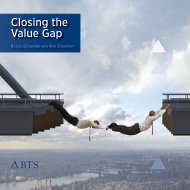Where Have all the General Managers Gone? - BTS
Where Have all the General Managers Gone? - BTS
Where Have all the General Managers Gone? - BTS
You also want an ePaper? Increase the reach of your titles
YUMPU automatically turns print PDFs into web optimized ePapers that Google loves.
<strong>BTS</strong><br />
INSIGHTS<br />
<strong>Where</strong> <strong>Have</strong> <strong>all</strong> <strong>the</strong> <strong>General</strong> <strong>Managers</strong> <strong>Gone</strong><br />
How High Potentials Can Make <strong>the</strong> Jump from Functional, Mid-Level<br />
Management Faster<br />
Written by Rommin Adl, Susan Burnett, and Rich Dapra Ph. D.<br />
“How do I build <strong>the</strong> general managers of <strong>the</strong><br />
future faster, so I have a pool of talent to<br />
take on new, large and complex leadership<br />
roles in an environment of turbulence and<br />
change”<br />
In recent months, this ch<strong>all</strong>enge was a<br />
primary concern for leading companies<br />
across industries. A top private equity<br />
firm is acquiring companies each year,<br />
but struggling to appoint effective CEOs<br />
and business unit heads. A fast-growing<br />
technology enterprise is engaging in rapid<br />
global expansion requiring leadership in<br />
new international businesses. A mature<br />
multinational conglomerate is losing <strong>the</strong><br />
key talent needed to drive growth in <strong>the</strong><br />
years ahead.<br />
So where have <strong>all</strong> <strong>the</strong> general managers<br />
gone<br />
<strong>General</strong> <strong>Managers</strong>: Critical but<br />
Scarce<br />
The combination of talent scarcity and skills<br />
mismatch constraining organizations across<br />
private, public and social sectors today only<br />
promises to get worse. 1 According to recent<br />
research, within <strong>the</strong> next eight years <strong>the</strong><br />
global shortage of highly skilled workers<br />
could reach just 13 percent of demand. 2<br />
For general management roles, <strong>the</strong> talent<br />
shortage is even more pronounced and <strong>the</strong><br />
stakes are especi<strong>all</strong>y high.<br />
As organizations evolved in <strong>the</strong> 1980s<br />
towards functional structures to increase<br />
efficiency, <strong>the</strong> focus shifted away from<br />
general management and broad business<br />
exposure and towards divided silos and<br />
specialization around a piece of <strong>the</strong><br />
company. 3 Three decades later, we have<br />
become a society of specialists, developing<br />
deep expertise within a specific field. Many<br />
leaders have never been exposed to <strong>the</strong> full<br />
end-to-end enterprise.<br />
Yet as businesses become more volatile and<br />
markets more uncertain and interconnected,<br />
general management capabilities are<br />
needed now more than ever. 4 Over <strong>the</strong> past<br />
four years, <strong>the</strong> average number of general<br />
managers reporting directly to <strong>the</strong> CEO<br />
has increased by 81 percent. Previously<br />
experienced in only a single silo or function,<br />
many leaders were unprepared for <strong>the</strong><br />
unique demands of <strong>the</strong> role. 5<br />
Transitioning from Functional<br />
Leader to <strong>General</strong> Manager, Few<br />
Succeed<br />
A strong track record and history of past<br />
achievements does not necessarily translate<br />
to success at <strong>the</strong> next level. Research reveals<br />
copyright © 2013 bts | contactus@bts.com | www.bts.com
<strong>BTS</strong><br />
INSIGHTS<br />
<strong>Where</strong> <strong>Have</strong> <strong>all</strong> <strong>the</strong> <strong>General</strong> <strong>Managers</strong> <strong>Gone</strong><br />
How High Potentials Can Make <strong>the</strong> Jump from Functional, Mid-Level<br />
Management Faster<br />
that 40 percent of high potentials promoted<br />
to <strong>the</strong> general management ranks fail. 6<br />
Reaching general management, leaders<br />
are ch<strong>all</strong>enged to evolve beyond <strong>the</strong>ir past<br />
leadership focus, transition outside of <strong>the</strong>ir<br />
functional roles, and rapidly grow <strong>the</strong>ir<br />
business skills to manage <strong>the</strong> greater scope<br />
in responsibility at <strong>the</strong> top. With tangible<br />
root causes, navigating <strong>the</strong>se shifts is<br />
difficult.<br />
Dan, a high-potential leader at a global<br />
financial services company, started as an<br />
analyst within <strong>the</strong> asset management group,<br />
but as his individual contribution soared and<br />
<strong>the</strong> performance of his team streng<strong>the</strong>ned,<br />
he quickly won promotion after promotion.<br />
As his string of accomplishments continued,<br />
Dan was elected <strong>the</strong> head of <strong>the</strong> company’s<br />
newly established Bangalore office. A<br />
few months into <strong>the</strong> position, Dan was<br />
struggling; office revenues were lagging<br />
and attrition was rising fast. At <strong>the</strong><br />
general management level, <strong>the</strong>se mistakes<br />
were significantly costing <strong>the</strong> company.<br />
Looking to expand within <strong>the</strong> region, <strong>the</strong><br />
performance of <strong>the</strong> office was critical to <strong>the</strong><br />
firm’s future growth opportunities. Soon<br />
enough, Dan was pressured to resign. Far<br />
from unique, this story is part of a familiar<br />
pattern.<br />
The Source of <strong>the</strong> Ch<strong>all</strong>enge<br />
Moving from a mid-level employee or<br />
functional manager to <strong>the</strong> ranks of general<br />
management, leaders are ch<strong>all</strong>enged to<br />
develop <strong>the</strong> following skills and mindsets:<br />
Functional/Mid-Level Manager<br />
Tactical Execution<br />
Implements initiatives set by <strong>the</strong> senior<br />
leadership team<br />
Silo Experience<br />
Experience and networks concentrated within<br />
one area of <strong>the</strong> enterprise<br />
Internal Focus<br />
Concentrated on strong execution, exposure<br />
to <strong>the</strong> external market is limited<br />
Cost/Budget Analysis<br />
Budgetary perspective, but limited financial<br />
acumen often exposed only to <strong>the</strong> P&L within<br />
<strong>the</strong>ir business unit<br />
Team Development<br />
Experienced in leading professionals and driving<br />
high-performance teams through fundamental<br />
leadership skills<br />
Working within <strong>the</strong> Business Today<br />
Effectively work within today’s business to<br />
maximize <strong>the</strong> current business model<br />
a<br />
a<br />
a<br />
Business/Financial<br />
a<br />
Enterprise<br />
a<br />
a<br />
<strong>General</strong> Manager<br />
Strategic Execution<br />
Demands big-picture, long-term and strategic<br />
thinking<br />
Broad Enterprise Perspective<br />
Maximize cross-business interdependencies and<br />
identify, collaborate and influence stakeholders<br />
External Focus<br />
Deep understanding of industry trends, market<br />
dynamics, regulatory changes and customer<br />
expectations is required<br />
Acumen<br />
Financial acumen and agility with a deep<br />
understanding of <strong>the</strong> balance sheet, cash flow<br />
statement and KPIs<br />
Talent Development<br />
Exhibit <strong>the</strong> behaviors needed to drive <strong>the</strong> company<br />
culture, inspire large groups of employees<br />
and acquire top talent<br />
Innovating <strong>the</strong> Business for Tomorrow<br />
Agility to innovate <strong>the</strong> business to create new<br />
opportunities for growth<br />
copyright © 2013 bts | contactus@bts.com | www.bts.com
<strong>BTS</strong><br />
INSIGHTS<br />
<strong>Where</strong> <strong>Have</strong> <strong>all</strong> <strong>the</strong> <strong>General</strong> <strong>Managers</strong> <strong>Gone</strong><br />
How High Potentials Can Make <strong>the</strong> Jump from Functional, Mid-Level<br />
Management Faster<br />
Bridging <strong>the</strong>se capability gaps as leaders<br />
transition to <strong>the</strong> enterprise ranks is not easy,<br />
but <strong>the</strong>y’re important to driving superior<br />
strategy execution and achieving business<br />
results.<br />
So Now What<br />
What’s <strong>the</strong> best way to bridge <strong>the</strong>se skill<br />
gaps and reduce <strong>the</strong> time to general<br />
management readiness In <strong>the</strong> past, a<br />
series of carefully identified two-to-three<br />
year stretch assignments would develop<br />
<strong>the</strong> skills and experiences needed to take<br />
on <strong>the</strong> general management ch<strong>all</strong>enges<br />
of <strong>the</strong> future. Over <strong>the</strong> course of eight to<br />
12 years, leaders would engage in several<br />
key assignments, learn <strong>the</strong> role and make<br />
an impact—or in some cases, make big<br />
mistakes costing revenues. Sometimes, <strong>the</strong><br />
assignments would be complemented by<br />
rare, one-off, formal learning initiatives.<br />
However, in today’s competitive and<br />
fast-paced economy, this approach and<br />
timeframe is no longer viable. Leadership<br />
requirements and ch<strong>all</strong>enges are changing<br />
too quickly to be relevant a decade later.<br />
Leaders are no longer willing to stay at<br />
one company and patiently develop over<br />
a decade; instead, <strong>the</strong>y are pursuing new<br />
opportunities, walking out <strong>the</strong> door and<br />
leaving a gap in <strong>the</strong> talent pipeline. While<br />
many companies continue to leverage<br />
assignments as <strong>the</strong>ir primary executive<br />
development tool, more and more are<br />
feeling <strong>the</strong> impact of its inadequacies.<br />
If <strong>the</strong> 12-year timeline and past approach is<br />
no longer relevant, how can we accelerate<br />
development and condense it down to two<br />
years To build <strong>the</strong> general managers of<br />
<strong>the</strong> future faster, we must simulate stretch<br />
assignments and ch<strong>all</strong>enges in immersive<br />
ways and faster timeframes.<br />
Accelerating <strong>the</strong> Development of High Potentials<br />
A Case Study from Chevron<br />
Chevron, a leading integrated oil and gas company, faces many difficult ch<strong>all</strong>enges in order to maintain its status as a leader<br />
in <strong>the</strong> space. The company recognizes <strong>the</strong> strategic development of high-potential leaders as critical to business success.<br />
To maximize <strong>the</strong> impact of its Advanced Management Program, Chevron immerses high-potential functional leaders in a<br />
designed experience.<br />
Through a competitive experiential learning program, leaders are ch<strong>all</strong>enged to assume <strong>the</strong> role of <strong>the</strong> senior leadership<br />
team responsible for <strong>the</strong> over<strong>all</strong> success of a simulated integrated oil company. Reflecting <strong>the</strong> company’s business, strategic<br />
priorities and external factors, <strong>the</strong> decisions and trade-offs made by <strong>the</strong> participating leaders are real choices that Chevron’s<br />
senior management grapples with daily. Managing <strong>the</strong> company’s entire business from exploration to <strong>the</strong> end consumer is<br />
a stretch for <strong>the</strong> group, but within this risk-free context, leaders learn great strategy implementation firsthand, so <strong>the</strong>y can<br />
ultimately take ownership and effectively execute back on <strong>the</strong> job.<br />
Nigel Hearne, Vice President of Strategy (Downstream) at Chevron reflected on <strong>the</strong> experience. “The program enabled<br />
participants to think more strategic<strong>all</strong>y, broadened enterprise perspectives, built financial acumen and provided an external<br />
focus and understanding of geopolitical decisions, competitive dynamics and customer and investor expectations. Most<br />
importantly, <strong>the</strong>y had <strong>the</strong> opportunity to practice and learn in context of <strong>the</strong> company’s business and strategic priorities.”<br />
For John Watson, Chevron’s Chairman and CEO, <strong>the</strong> intensive experiential learning program was a success. “I was skeptical<br />
at first about <strong>the</strong> value of <strong>the</strong> simulation, but I am now a strong believer in how much a simulation can provide a rich and<br />
efficient learning platform for our high potential leaders.”<br />
copyright © 2013 bts | contactus@bts.com | www.bts.com
<strong>BTS</strong><br />
INSIGHTS<br />
<strong>Where</strong> <strong>Have</strong> <strong>all</strong> <strong>the</strong> <strong>General</strong> <strong>Managers</strong> <strong>Gone</strong><br />
How High Potentials Can Make <strong>the</strong> Jump from Functional, Mid-Level<br />
Management Faster<br />
To maximize impact, corporate development<br />
programs must move beyond <strong>the</strong> world of<br />
“curriculum” and evolve towards “designed<br />
experiences,” where talent leaders create and<br />
deliver frequent, high-impact experiences<br />
with <strong>all</strong> <strong>the</strong> characteristics, ch<strong>all</strong>enges and<br />
accountability of stretch assignments done<br />
well. “In <strong>the</strong> VUCA world [volatile, uncertain,<br />
complex and ambiguous],” says Bob<br />
Johansen, Distinguished Fellow from <strong>the</strong><br />
Institute for <strong>the</strong> Future, “immersive learning,<br />
experiential learning, is <strong>the</strong> pedagogy of<br />
choice, because it’s not just a fixed body<br />
of knowledge that you want to transfer. It’s<br />
a whole contextual set of lessons that you<br />
have to learn almost at <strong>the</strong> muscle memory<br />
level, to make <strong>the</strong>m real.”<br />
Through <strong>the</strong>se immersive, high-impact and<br />
ongoing experiences, years of business<br />
exposure can be condensed, accelerated<br />
and retained. Just like <strong>the</strong> assignments of<br />
<strong>the</strong> past, a high level of responsibility for<br />
learning and performance is maintained in a<br />
risk-free environment. Like a pilot in a flight<br />
simulator, business leaders experience realworld<br />
ch<strong>all</strong>enges, execute new tasks, and<br />
perform new roles in different contexts and<br />
competitive market conditions.<br />
The Way Forward<br />
The future has always been uncertain, but<br />
in today’s interconnected, fast-paced and<br />
ever changing global economy, general<br />
management capabilities are desperately<br />
needed to remain competitive. “Those<br />
who know many things, draw from an<br />
eclectic array of traditions, and accept<br />
ambiguity and contradictions” are more<br />
likely to effectively predict business trends,<br />
innovate, effectively execute and rise to<br />
<strong>the</strong> top,” suggests Vikram Mansharamani in<br />
Harvard Business Review. 7<br />
Unfortunately, for many organizations,<br />
general manager talent is not strong<br />
enough, <strong>the</strong> development pipeline is taking<br />
too long, and <strong>the</strong> leadership requirements<br />
are evolving so rapidly that <strong>the</strong> capabilities<br />
of today quickly become irrelevant.<br />
With this trend spanning across industries<br />
and geographies, organizations can no<br />
longer afford to wait 10 years to develop <strong>the</strong><br />
general managers of <strong>the</strong> future. Companies<br />
are ch<strong>all</strong>enged to move beyond previous<br />
approaches and development timeframes to<br />
effectively design experiences that meet <strong>the</strong><br />
demands of <strong>the</strong> business today. The need is<br />
great, <strong>the</strong> business benefits are significant, and<br />
success demands courageous, bold action.<br />
1 “Skills Mismatches: Business Acumen and Strategy<br />
Execution”, <strong>BTS</strong> Research Report, Survey Conducted by The<br />
Economist Intelligence Unit, 2013.<br />
2 “Redesigning Knowledge Work”, Harvard Business Review<br />
Jan.-Feb. 2013, 58-64.<br />
3 Ashkenas, Ron “Bring Back <strong>the</strong> <strong>General</strong> Manager”, HBR Blog<br />
Network, Harvard Business Review, 18 Jul. 2012.<br />
4 Wiens, Kyle, “In Defense of Polymaths”, HBR Blog Network,<br />
Harvard Business Review, 10 Jul. 2012.<br />
5 Nobel, Carmen, “Crowded at <strong>the</strong> Top: The Rise of <strong>the</strong><br />
Functional Manager”, Working Knowledge, Harvard Business<br />
Review, 12 Mar 2012.<br />
6 “Employee Value Proposition Survey”, Corporate Leadership<br />
Council, Human Capital Practice, 2009.<br />
7 Mansharamani, Vikram, “All Hail <strong>the</strong> <strong>General</strong>ist”, HBR Blog<br />
Network, Harvard Business Review, 4 Jun. 2012.<br />
_______________________________<br />
<strong>BTS</strong> is a world leading strategy<br />
implementation firm that accelerates<br />
execution by building <strong>the</strong> alignment, mindset<br />
and capability needed to deliver superior<br />
business impact. The company leverages<br />
customized business simulations and<br />
experiential learning initiatives to help clients<br />
achieve better results, faster.<br />
For more information,<br />
please visit www.bts.com.<br />
About <strong>the</strong> Authors-<br />
Rommin Adl is an<br />
Executive Vice President<br />
at <strong>BTS</strong>.<br />
Susan Burnett is a<br />
Vice President of <strong>the</strong><br />
Leadership Development<br />
Practice at <strong>BTS</strong>.<br />
Rich Dapra is a<br />
Managing Director-<br />
Assessment at <strong>BTS</strong>.<br />
Contributor-<br />
Caroline Meyer is an<br />
Associate Marketing<br />
Manager at <strong>BTS</strong>.<br />
copyright © 2013 bts | contactus@bts.com | www.bts.com


